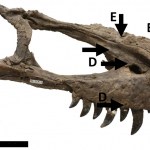taphonomy
The number one rule of the Taphonomy Club is don't talk about marks on bones ... without placing them in context. Many marks on bones could have multiple causes, such as putative cut marks caused by stone tools on animal bones found on early hominid sites. In that case, hard sharp stony objects in the ground can cause marks that are hard to tell apart from stone tool marks. But when you find almost all the possible stone tool marks in the exact locations they would be if a hominid was butchering or defleshing the animal, then you can assert that that butchery or defleshing with stone tools…
The trailer for Shaun of the Dead.
Not all zombies are created equal. The most popular zombie archetype is a shambling, brain-eating member of the recently deceased, but, in recent films from 28 Days Later to Zombieland, the definition of what a zombie is or isn't has become more complicated. Does a zombie have to be a cannibal corpse, or can a zombie be someone infected with a virus which turns them into a blood-crazed, fast-running monster?
For my own part, I have always preferred the classic George Romero zombies from the original Dawn of the Dead and Day of the Dead films (as well as…
The skull of a spotted hyena (Crocuta crocuta), photographed at the AMNH's "Extreme Mammals" exhibit.
There was something strange about the assemblage of Homo erectus fossils found at Zhoukoudian - the famous 750,000 - 200,000 year old site in China popularly known as Dragon Bone Hill. Despite the abundance of skulls and teeth, there were hardly any remains of the hominins from below the neck. Where were the bodies?
The majority of Homo erectus fossils from Zhoukoudian were discovered and studied by an international team of scientists during the 1920's and 1930's. (Unfortunately most of…
The skeletons of female (larger, background) and male (smaller, foreground) Dinornis robustus, with a pigeon skeleton for comparison. From Allentoft et al 2010.
A little more than 700 years ago, multiple species of the gigantic, flightless birds called moas were still running around New Zealand. They ranged over almost the entirety of the North and South Islands, from the coast to the mountain forests, but when the Maori people arrived in the late 13th century the birds were quickly driven to extinction. Within a few hundred years they were entirely wiped out (along with the immense Haast…
Breaking down a hyena kill. Given competition with other carnivores, prehistoric hyenas (like their living counterparts) would probably have disarticulated and transported parts of horses they killed. From Diedrich 2010.
In Hollywood films, there is nothing like an assemblage of bones strewn about a cave floor to testify to the power and voraciousness of a predator. Every skeleton is a testament to the hunting prowess of the carnivore, which causes even more alarm when the person who has stumbled into the cave realizes that they have just walked into a literal dead-end.
Although amplified…
For deep sea scavengers, a dead tuna is an exquisite feast. For more on what happens to bodies which come to rest on the seafloor, see my post on bone-eating worms and this video of a whale fall.
A leopard (Panthera pardus). Image from Wikipedia.
When a leopard eats a baboon, what is left behind? This question is not only relevant to primatologists and zoologists. Even though instances of predation on humans is relatively rare, big cats still kill and consume people, and when they do they can virtually obliterate a body. Yet, just like a human criminal, the dining habits of big cats leave tell-tale clues, and in 2004 researchers Travis Pickering and Kristian Carlson fed two captive leopards eight complete baboon carcasses each in order catalog the most useful ways to identify the…
The fail whale comes to rest; the decomposing body of a gray whale is host to a diverse array of scavengers and other deep sea organisms. From Goffredi et al., 2004.
In the deep sea, no carcass goes to waste. Platoons of crabs, fish, and other scavengers make short work of most of the bodies which come to rest on the sea bottom, but every now and then the carrion-eaters are presented with a rotting bonanza; a whale fall. Muscle, viscera, blubber, and bone; it all gets broken down, but it takes so long that the whale carcass actually provides a temporary home for a variety of organisms…
tags: evolutionary biology, paleontology, taphonomy, plumage color, feathers, color, melanin, eumelanin, phaeomelanin, dinosaurs, theropod, paravian, avialae, fossils, Anchiornis huxleyi, ornithology, birds, researchblogging.org,peer-reviewed research, peer-reviewed paper
New research reveals that recently-described 155-million-year-old Anchiornis huxleyi,
a woodpecker-like dinosaur the size of a modern-day domesticated chicken,
had black-and-white spangled wings and a rusty red crown.
Image: Michael DiGiorgio, Yale University [larger view]
Fig. 4. Reconstruction of the plumage color of…
tags: evolutionary biology, paleontology, fossils, fossilization, fossil forensics, Taphonomy, taxonomy, zoology, deep time, paleoceanography, amphioxus, Branchiostoma lanceolatum, lamprey, Lampetra fluviatilis, chordates, researchblogging.org,peer-reviewed research, peer-reviewed paper
Three rotting Amphioxus heads.
A sequence of images showing how the characteristic features of the body of amphioxus, a close living relative of vertebrates, change during decay. Colours are caused by interference between the experimental equipment and the light illuminating the specimens.
Image: Mark…
Or, more accurately, did these dinosaurs either engage in intraspecific combat (such as territorial or mating contests among males) or fight predators such as Tyrannosaurs, like in the movies?
Well, one thing we know for sure: If any folklore, belief, or 'fact' related to a fossil species sits around long enough, eventually someone will come along and study it. This usually involves reformulating the idea as one or more testable hypotheses, then attacking the hypotheses ... much like Tyrannosaurus might or might not have attacked Triceratops, to see if it can be killed, or alternatively,…
